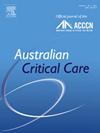Critical care nurses’ responses to clinical scenarios involving cardiopulmonary resuscitation for deceased inpatients without a Do Not Resuscitate order: A cross-sectional study
IF 2.7
3区 医学
Q2 CRITICAL CARE MEDICINE
引用次数: 0
Abstract
Background
Current Australian resuscitation training focusses on the practical application of cardiopulmonary resuscitation but lacks clarity on when it is inappropriate. Nurses are often first responders to inpatient emergencies and may take different approaches to cardiopulmonary resuscitation due to their views about its benefit. There is a lack of literature on how the absence of Do Not Resuscitate orders affect nurses’ decisions regarding resuscitation in hospital settings.
Objective
The aim of this study was to explore nurse's views of initiating cardiopulmonary resuscitation on inpatients with unequivocal signs of death without a Do Not Resuscitate order, using hypothetical scenarios.
Methods
The cross-sectional survey recruited nurses across five Australian hospitals between October 2023 and April 2024. Participants were provided two hypothetical clinical scenarios (scenario 1: Mr D, an 84-year-old man; scenario 2: Mr G, a 35-year-old man). In both scenarios, the patients had unequivocal signs of death and absent Do Not Resuscitate orders. Respondents were asked to indicate their actions. Responses from participants working in the intensive care unit, emergency department, or critical care are reported here. Results were analysed using descriptive statistics.
Results
Eighty participants working in the intensive care unit, emergency department, or critical care completed the survey. Most nurses indicated they would call a Code Blue and initiate full resuscitation in both scenarios (scenario 1: 51.3% [n = 41] vs scenario 2: 92.5% [n = 74]). Fear and a misunderstanding of the law was a recurring reason for initiating resuscitation in both scenarios. Ethical judgement and family's expectations were predominant reasons for initiating resuscitation for the younger patient (scenario 2).
Conclusions
Most nurses working in the intensive care unit, emergency department, or critical care areas chose to call a Code Blue and initiate full resuscitation in both scenarios where patients showed unequivocal signs of death and an absent Do Not Resuscitate order. Nurses' decisions were influenced by multiple factors, including patient's age and misconception of the law.
重症监护护士对无禁止复苏令的住院死亡患者心肺复苏临床情景的反应:一项横断面研究
目前澳大利亚的复苏培训侧重于心肺复苏的实际应用,但缺乏对何时不适当的明确。护士通常是住院紧急情况的第一响应者,由于他们对心肺复苏的好处的看法,可能会采取不同的方法。缺乏关于不复苏命令的缺失如何影响护士在医院环境中关于复苏的决定的文献。目的本研究的目的是探讨护士的观点启动心肺复苏对住院患者明确的死亡迹象,没有不复苏令,采用假设的情况下。方法横断面调查于2023年10月至2024年4月在澳大利亚五家医院招募护士。参与者被提供了两种假设的临床场景(场景一:D先生,一位84岁的男性;情景2:G先生,35岁)。在这两种情况下,患者都有明确的死亡迹象,并且没有“不复苏”命令。受访者被要求说明他们的行为。在这里报告了在重症监护室、急诊科或重症监护室工作的参与者的反应。结果用描述性统计进行分析。结果80名在重症监护室、急诊科或重症监护室工作的参与者完成了调查。大多数护士表示,在这两种情况下,他们都会拨打蓝色警报并启动全面复苏(场景1:51.3% [n = 41] vs场景2:92.5% [n = 74])。在这两种情况下,恐惧和对法律的误解是启动复苏的一个反复出现的原因。伦理判断和家庭期望是启动年轻患者复苏的主要原因(场景2)。结论:在重症监护室、急诊科或重症监护室工作的大多数护士在两种情况下都选择呼叫蓝色代码并启动全面复苏,即患者有明确的死亡迹象和没有禁止复苏令。护士的决定受到多种因素的影响,包括患者的年龄和对法律的误解。
本文章由计算机程序翻译,如有差异,请以英文原文为准。
求助全文
约1分钟内获得全文
求助全文
来源期刊

Australian Critical Care
NURSING-NURSING
CiteScore
4.90
自引率
9.10%
发文量
148
审稿时长
>12 weeks
期刊介绍:
Australian Critical Care is the official journal of the Australian College of Critical Care Nurses (ACCCN). It is a bi-monthly peer-reviewed journal, providing clinically relevant research, reviews and articles of interest to the critical care community. Australian Critical Care publishes peer-reviewed scholarly papers that report research findings, research-based reviews, discussion papers and commentaries which are of interest to an international readership of critical care practitioners, educators, administrators and researchers. Interprofessional articles are welcomed.
 求助内容:
求助内容: 应助结果提醒方式:
应助结果提醒方式:


